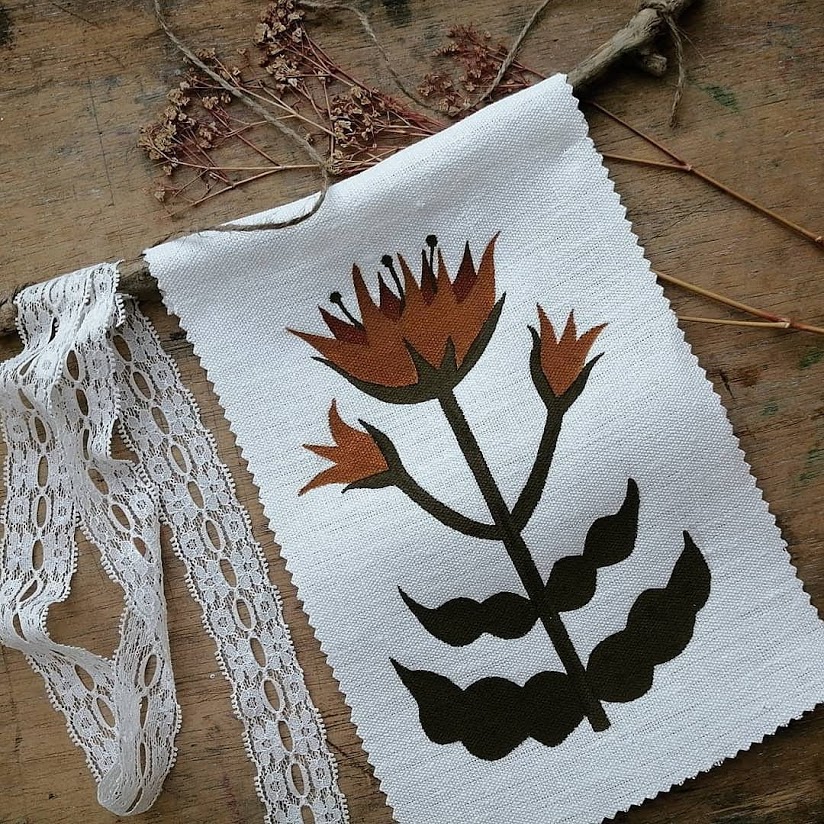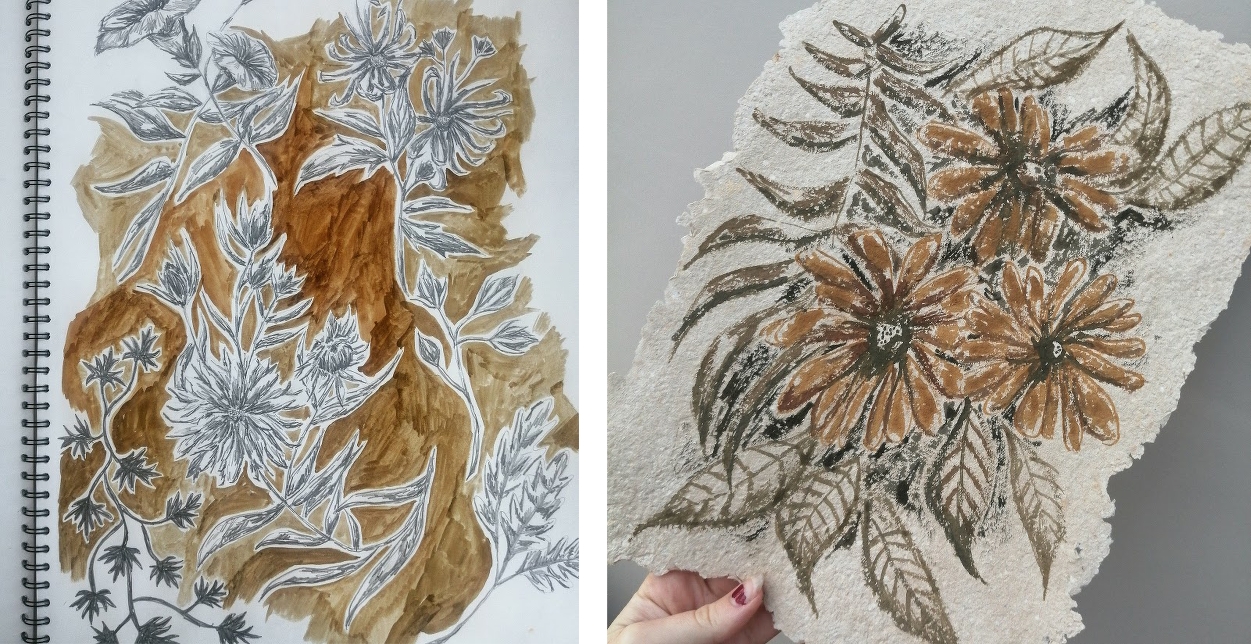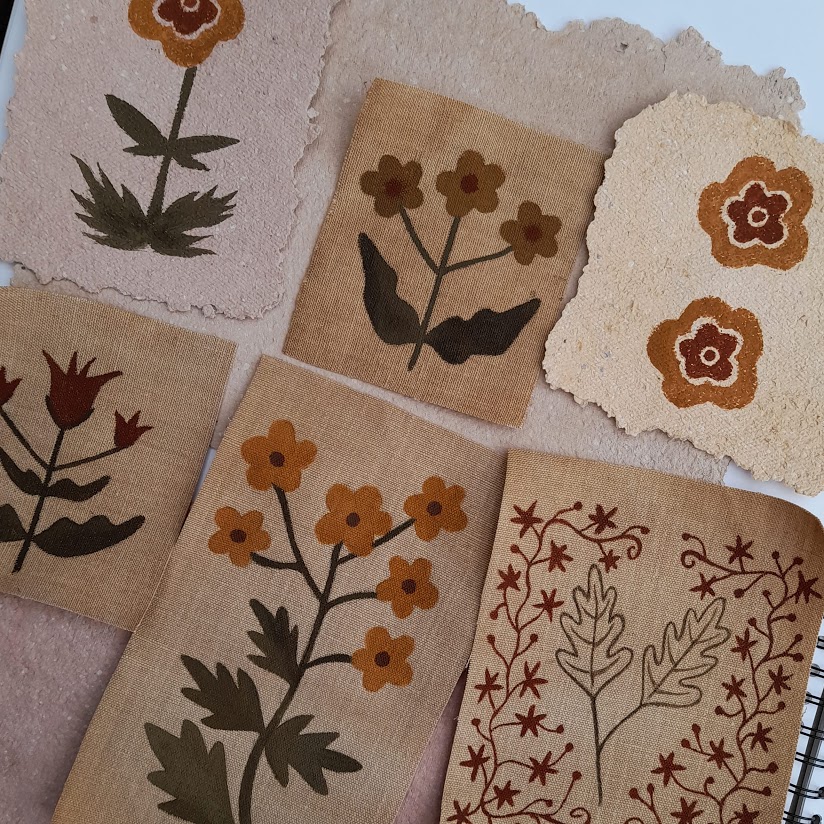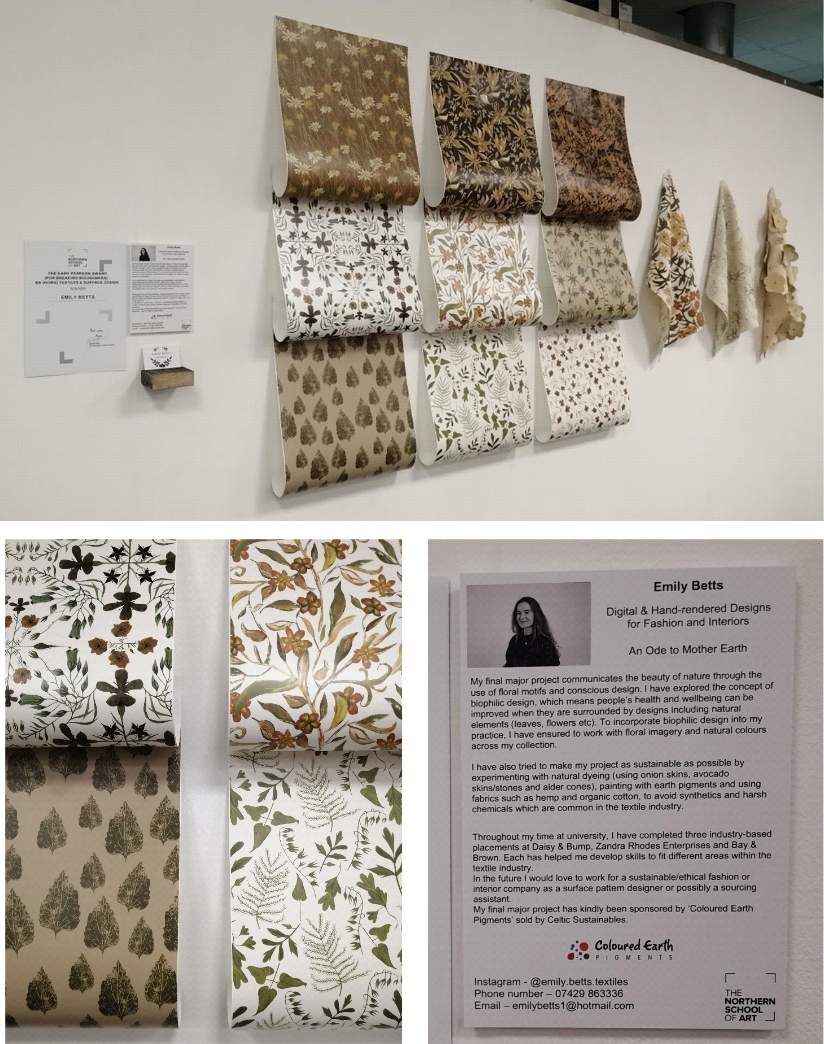Designer Emily Betts on creating her beautiful organic textiles with Coloured Earth Pigments
Posted by Celtic Sustainables on 10th Aug 2021
North Yorkshire based designer Emily Betts has a passion for sustainable textiles and tries to be as eco-friendly as possible in her practices...

Emily’s beautifully hand painted designs are created using coloured earth pigments…
Just completing her final year of a BA (Hons) degree in Textiles and Surface Design at The Northern School of Art, Emily Betts has been busy using our natural Coloured Earth pigments for over a year and we think the results are just stunning.
It’s always exciting to hear about the work people are doing and the new and creative ways our pigments are used, and we think you’ll agree that Emily’s work is no exception. Here’s what she told us about her work, the inspiration behind it, why sustainability is so important to her and her aspirations for the future…
Your work looks very organic and natural – where does your inspiration come from Emily?
“My biggest source of inspiration is the area I grew up in Marske-by-the-Sea, North Yorkshire. I spent my childhood running on the beach, playing in fields and collecting flowers from the woods. This has definitely had an influence on my work as I’ve noticed the majority of my paintings and drawings consist of natural colours and objects which I was surrounded by throughout my life.”
Studying during the pandemic this past year must have been very different for you, how did that go?
“I’ve spent a lot of my final year at home researching for my final project and dissertation. My dissertation was all about sustainability and ethics in the textiles industry and it really opened my eyes to the harm the industry is doing to the planet and the people involved. I became a little uncomfortable working with synthetic fabrics and harmful chemicals, and therefore researched other methods.
I also took some online courses about sustainable fashion which introduced me to the UN’s Sustainable Development Goals, the idea of a circular economy, and brand transparency. These were all really beneficial things to learn and made me determined to try and be as sustainable and ethical within my practise as I can be.”
It’s great to hear about your interest in the sustainable and ethical aspects of the textile industry, have you come across the ‘ Cradle to Cradle’ standard in your research? With only 82 products worldwide within the Fashion and Textiles sector currently certified - it seems pretty low. As an eco company we are always keen to demonstrate the environmental aspects of the products we sell (we have several paints in our product range, Airlite and Graphenstone, for example, which are Cradle to Cradle certified) – what are your views on the low uptake up in your field?
“When writing my dissertation I came across the ‘Cradle to Cradle’ certification which recognises safer, sustainable products created for the circular economy. I’d read about how many textile products and fashion brands do not have the Cradle to Cradle certification meaning their practises may not be sustainable or ethical. This worries and saddens me as I feel these are important factors that should be at the centre of each brand, as our planet is suffering and so are the people creating the products. For my final university project, I wanted my work to have minimum impact on the planet by using biodegradable fabrics and sustainable dyes/pigments. That’s why I wanted to work alongside an eco-conscious company like Celtic Sustainables and Coloured Earth Pigments - one of the only brands I managed to source sustainable pigments from that work well on fabrics.”
Your final year project is entitled ‘An Ode to Mother Earth’ and in it, you have been experimenting with various different techniques which are kinder to the planet – can you tell us a little more about that?
“I have explored hand-painting onto fabrics with Coloured Earth Pigments, created my own recycled paper which I added colour to using the pigments and painted onto the paper, which I then scanned into my laptop to create digital designs from. Painting motifs and manipulating them using digital techniques is my favourite way to work, as it gives the designs a hand-rendered look whilst making it easier for accurate measurements."

Emily’s hand painted designs and handmade recycled paper with Coloured Earth pigments
Alongside the work I produced using the Coloured Earth Pigments, I’ve also been working with natural dyes to create a range of colours on hemp fabric. For my final project, I created dyes from onion skins, avocado skins/stones, and alder cones. From these dyes, I created beautiful browns, oranges and pinks which I was then able to turn into other colours using different modifiers such as iron water.”

A selection of Emily’s work on hemp and handmade paper, with natural dyes and coloured earth pigments.
The paint you made with Coloured Earth pigments seems to have worked really well. Our customers are also often experimenting with pigments, as are we (we’ve dabbled in making some fabric dye with Coloured Earth pigments and soya milk, as well as watercolours and artists soft pastels quite successfully). I used Gum Arabic for my watercolours but there’s lots of trial an error with these things – how did you find it and do you have any tips you could share on what you learned?
“I experimented with creating my own paints from Coloured Earth Pigments by mixing them with a range of different binders. I tried Medieval recipes such as mixing the pigments with egg yolks, honey, Gum Arabic and soymilk. I found Gum Arabic worked best and could be made into a gouache consistency which is my favourite way to paint but it could also be watered down to create a watercolour consistency too. When painting with the pigments onto fabric, I found that using an alum mordant on the fabric and adding some alum powder to the pigment/Gum Arabic mixture made the colours stay on the fabric well after leaving it for a few weeks and then ironing it.”
Your final year show looks really great and we hear you also won the Gary Pearson Award for Breaking Boundaries in Design, for your use of sustainable materials and techniques – HUGE CONGRATULATIONS!
Where would you like to see your work going in the future?
“I would love to work within the surface design industry and it would be great to find a company that takes sustainability and ethics seriously. I am also planning on selling little pieces of work on my Etsy shop.”

Images from Emily’s final BA (Hons) Degree show…
Find out more about Emily Betts design work at her website and on Instagram @emily.betts.textiles.
Emily also sells a selection of her unique pieces through her Etsy shop.
Inspired to create your own eco-friendly designs?
There are many how to guides to making natural paint on the Coloured Earth Pigments website including how to make watercolours, oil paints and your own soft pastels!
And of course, you can purchase your non-toxic, earth and mineral based pigments from us via our Coloured Earth Pigment pages..


